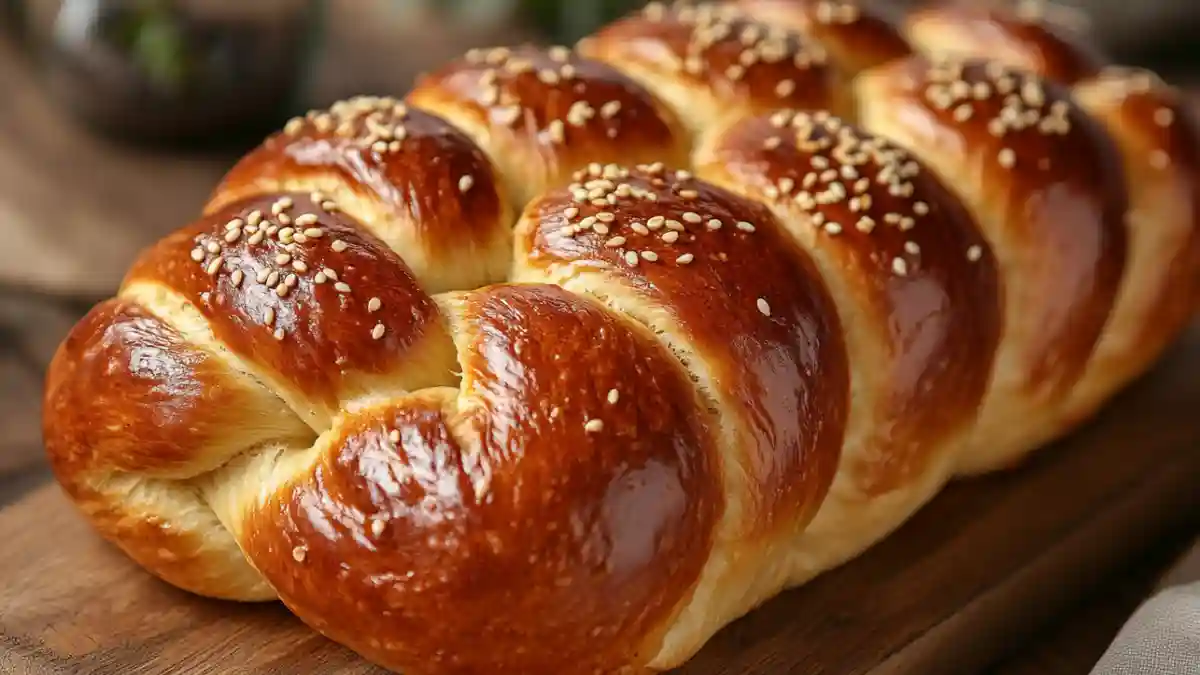Challah buns are soft, slightly sweet, and beautifully golden rolls that carry deep cultural roots and amazing culinary versatility. Whether you’re crafting a gourmet burger or planning a Shabbat meal, challah buns elevate the experience with their rich flavor and fluffy texture. In this guide, we’ll explore what makes challah buns special, how they differ from brioche, which flour to use, and even how to bake them at home like a pro.
You’ll also discover why challah has religious significance in Jewish tradition, how to store it properly, and why it’s a go-to bun for everything from breakfast sliders to burger night. Don’t miss our step-by-step dinner roll recipe that pairs perfectly with what you’ll learn here.
Let’s dive in.
What Is a Challah Bun?
Origin and Tradition Behind Challah Buns
Challah is a traditional Jewish bread enjoyed especially during Shabbat and other Jewish holidays. Its roots trace back to Eastern Europe, where it was braided and served as a sacred symbol of sustenance, celebration, and spirituality. Over time, bakers began adapting challah into smaller forms—challah buns—for convenience and versatility.
These buns aren’t just mini versions of the loaf—they’re individually shaped portions that maintain the same rich, eggy texture and golden exterior. Their name and purpose might be modernized, but the essence is timeless.
The challah bun’s deep ties to Jewish culture are reflected in its careful preparation. According to Jewish law, two loaves are traditionally placed on the Sabbath table, symbolizing the double portion of manna God provided to the Israelites. While loaves are common, buns have now become a staple in both religious and secular kitchens alike.
Difference Between Challah Bread and Challah Buns
At their core, challah buns and challah loaves share the same ingredients—flour, eggs, sugar, yeast, oil, and salt. The difference lies in size and shape. A loaf is often braided into a long, elegant structure meant for slicing, while buns are individually portioned, rounded or braided, and perfect for serving one person.
Here’s a quick breakdown:
| Feature | Challah Loaf | Challah Bun |
|---|---|---|
| Size | Large braided loaf | Individual portions |
| Common Uses | Sliced for meals | Burgers, sliders |
| Baking Time | 25–35 minutes | 15–20 minutes |
| Ideal For | Sharing, rituals | Sandwiches, parties |
While the dough is often identical, shaping and portioning change the outcome. The bun’s smaller size gives it a crispier exterior and a tender, more evenly cooked interior—perfect for modern meals.
Many artisan bakers also sprinkle challah buns with sesame or poppy seeds and use a shiny egg wash to boost their golden finish, a step you’ll find in our egg wash guide.
Challah Bun vs Brioche – What Sets Them Apart?
Key Differences in Ingredients and Texture
At first glance, challah buns and brioche rolls may seem like twins—both are soft, golden, and rich. But there’s a world of difference once you look closer at the ingredients and bite into them.
Challah buns are made with:
- Flour
- Eggs
- Oil (not butter)
- Sugar
- Yeast
- Salt
- Water
Brioche, on the other hand, contains:
- Flour
- Eggs
- Butter (and lots of it)
- Milk
- Sugar
- Yeast
- Salt
The biggest difference lies in the fat source. Challah uses oil, which keeps it parve (non-dairy) in Jewish dietary laws, making it suitable for meals containing meat. Brioche uses butter, which makes it richer and more indulgent, but not kosher when served with meat.
| Feature | Challah Bun | Brioche Roll |
|---|---|---|
| Fat Source | Oil | Butter |
| Texture | Fluffy and light | Rich and buttery |
| Flavor | Slightly sweet, eggy | Rich, savory-sweet |
| Kosher-Friendly | Yes (pareve) | No (contains dairy) |
This difference gives challah buns a unique lightness while still being soft and rich. They’re easier on the stomach, and ideal if you want something indulgent without the heaviness of brioche.
Which Is Better for Sweet or Savory Recipes?
This depends on what you’re cooking. Here’s how to decide:
- For Savory Meals (like burgers or sandwiches):
Challah buns are often preferred. Their slightly sweet flavor balances salty and meaty fillings without overpowering them. They’re also less greasy than brioche, making them perfect for layering with ingredients like lettuce, tomato, and cheese. - For Sweet Treats (like French toast or bread pudding):
Brioche usually wins. Its buttery richness soaks up syrups and custards beautifully.
Still, challah buns can hold their own in sweet recipes. In fact, if you’ve got a few day-old buns, try using them in French toast bakes or even a gooey bread pudding. For a fun twist, check out this idea in our sourdough bread recipe hack where the texture is transformed into something unforgettable.
So, is challah just brioche? Not at all—they’re close cousins, but challah buns stand out with their lighter texture, kosher-friendly profile, and their versatility in both cultural and culinary spaces.
Core Ingredients in a Challah Bun Recipe
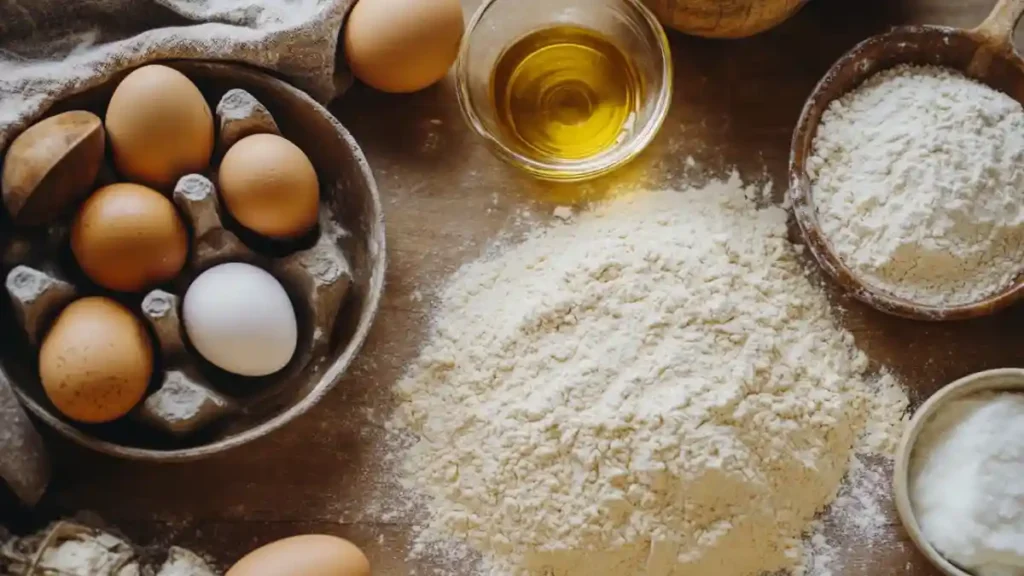
Essential Components: Flour, Eggs, and Oil
At the heart of every fluffy challah bun is a handful of pantry staples working in perfect harmony. Let’s break down the core ingredients and what each brings to the table:
- Flour: The structural backbone. Most traditional recipes use either all-purpose or bread flour. Bread flour contains more gluten, giving the dough more elasticity and chew. We’ll dig deeper into flour types in Part 4.
- Eggs: These are what make challah buns shine—literally and figuratively. Eggs enrich the dough, adding moisture, flavor, and a soft, springy texture. They also contribute to the golden-brown finish when used in an egg wash before baking.
- Oil: Challah is dairy-free, so it uses oil instead of butter. This creates a moist crumb without the richness of brioche. Traditional recipes call for neutral oils like canola or vegetable oil, though olive oil works too for a slightly earthier flavor.
These three ingredients are the core of the challah bun’s identity—light, tender, golden, and just rich enough.
| Ingredient | Role in Dough | Notes |
|---|---|---|
| Flour | Provides structure | Bread flour = more chew |
| Eggs | Adds richness & color | Also used in egg wash |
| Oil | Moistens & softens crumb | Keeps recipe dairy-free |
Looking for inspiration? Try our omelet-in-a-bag recipe alongside a fresh challah bun—it’s a game changer for busy mornings.
Sweetness, Texture & Shine: Role of Sugar and Egg Wash
While flour, eggs, and oil build the base, it’s the small ingredients that complete the profile of a perfect challah bun:
- Sugar: A small but critical amount (often 2–4 tablespoons per batch) lends challah buns a hint of sweetness. It also supports yeast fermentation, helping the dough rise faster and with better flavor.
- Salt: Balances the sweet notes and strengthens the gluten structure. Never skip it.
- Yeast: Usually active dry yeast or instant yeast is used. It’s the powerhouse that makes the dough light and airy.
- Egg Wash: This is what gives challah its shiny, picture-perfect top. An egg mixed with water or milk is brushed over the buns just before baking. You can find a step-by-step breakdown in our egg wash tutorial.
- Toppings (optional): Traditionally, challah buns are sprinkled with poppy seeds or sesame seeds before baking. Some variations include herbs, garlic, or even coarse salt for a savory twist.
Whether you stick with classic ingredients or try a gourmet take, every element in a challah bun works together to deliver that rich, soft bite that’s unlike any other bun.
Choosing the Best Flour for Challah Buns
All-Purpose vs Bread Flour: What’s Ideal?
When baking challah buns, one of the most important choices is the type of flour you use. It may seem like a minor detail, but it directly impacts your buns’ texture, chewiness, and rise.
Let’s break down the two most common flour options:
| Flour Type | Protein Content | Resulting Texture | Best For |
|---|---|---|---|
| All-Purpose Flour | 9–11% | Soft, tender, light | Traditional challah buns |
| Bread Flour | 12–14% | Chewy, structured, bakery-style | Buns needing a strong rise |
All-purpose flour is often the go-to for home bakers. It produces a light, slightly chewy texture that’s perfect for classic challah buns. It’s also easier to handle and forgiving if your kneading technique isn’t bakery-level.
However, if you’re after more structure and a slightly chewier bite, bread flour is the winner. Its higher protein level supports more gluten development, creating that ideal stretch and lift—especially if you’re shaping intricate braids or buns.
Pro Tip: If you want the best of both worlds, try using a 50/50 blend of bread and all-purpose flour. This creates buns that are light yet still hold their shape beautifully.
Gluten Structure and Elasticity in Challah Dough
Gluten is what gives dough its elasticity and strength. When you knead challah dough, you’re developing those gluten strands that will trap gas bubbles from the yeast, helping the dough rise.
With challah buns, it’s crucial to find the right balance:
- Too little gluten: Your buns will collapse or feel too crumbly.
- Too much gluten: You’ll end up with tough, chewy bread instead of soft and airy rolls.
Here’s how to optimize your gluten structure:
- Use higher-protein flour (like bread flour) if you want a sturdier bun for burgers.
- Knead the dough for 8–10 minutes until it becomes smooth and elastic.
- Let it rise fully—twice. First for bulk fermentation, then again after shaping.
Looking for a guide to flour conversions or baking measurement hacks? Check out our kitchen conversion reference for easy tips.
Once you’ve picked the right flour and handled the dough properly, the result is a challah bun that’s light, structured, and irresistibly golden.
How to Make the Perfect Challah Buns at Home
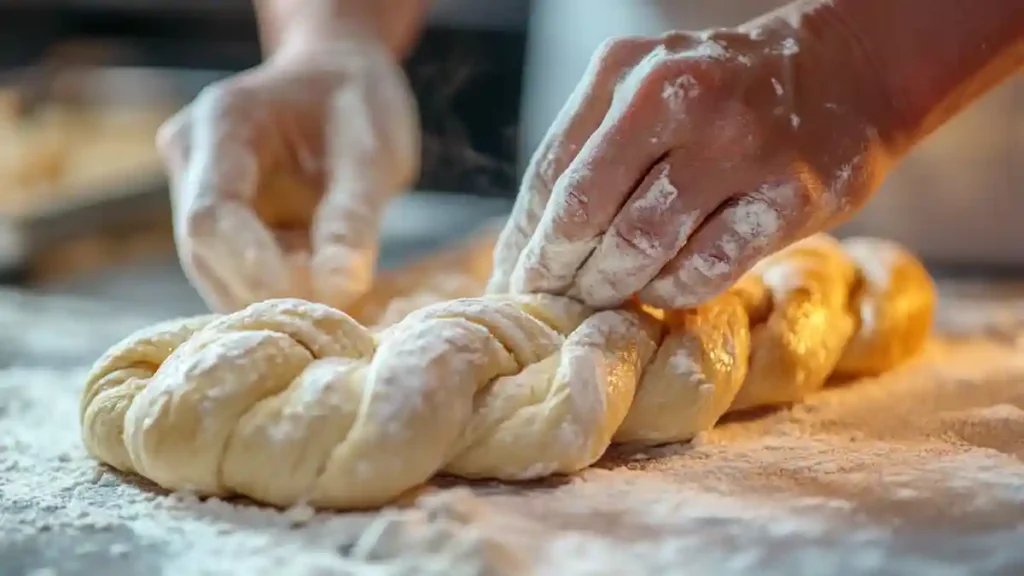
Step-by-Step Dough Preparation and Kneading
Baking challah buns at home might sound intimidating, but it’s surprisingly simple when you follow the right steps. Here’s a straightforward guide to making rich, fluffy buns that rise beautifully and taste amazing.
Ingredients You’ll Need:
- 4 cups all-purpose or bread flour
- 2 ¼ tsp instant yeast
- 2 large eggs
- ¼ cup vegetable oil
- ¼ cup sugar
- 1 tsp salt
- ¾ cup warm water
- 1 egg + 1 tbsp water (for egg wash)
- Optional: sesame or poppy seeds for topping
Instructions:
- Activate the Yeast (if using active dry):
Mix yeast with warm water and a pinch of sugar. Let sit for 5–10 minutes until foamy. - Combine Wet Ingredients:
Beat eggs, oil, and sugar in a large bowl. Add yeast mixture and whisk until blended. - Add Dry Ingredients:
Gradually stir in flour and salt. Once it becomes too thick to mix, switch to kneading. - Knead the Dough:
On a floured surface, knead for 8–10 minutes until dough is soft, elastic, and slightly tacky.
Don’t skip kneading—this is what builds the gluten needed for the buns to rise properly. - First Rise:
Place dough in a greased bowl, cover with a towel or plastic wrap, and let rise in a warm spot for 1 to 2 hours, or until doubled in size.
Want to bake without stress? Learn about kneading tips and proofing times in our homemade dinner roll tutorial.
Braiding or Shaping Buns – Traditional vs Creative Styles
Once your dough has risen, it’s time to shape your challah buns. You can stick with classic round shapes, or try something more decorative.
Shaping Options:
| Style | Look | Best For |
|---|---|---|
| Round Rolls | Simple ball shape | Sliders, burgers |
| Knots | Twisted like pretzel rolls | Fancy sandwiches or sides |
| Mini Braids | Small, 3-strand braided buns | Shabbat or holiday tables |
| Pull-apart Tray | Baked together in a dish | Party serving or centerpiece breads |
Steps to Shape:
- Divide dough into 8–12 equal pieces.
- For round buns: Roll into tight balls and pinch bottoms to seal.
- For braids: Divide each dough portion into three thin ropes and braid tightly.
- Place on a parchment-lined baking sheet and let rise again for 30–45 minutes.
Final Touch:
Brush the tops with egg wash and sprinkle with sesame seeds. Bake at 350°F (175°C) for 18–22 minutes, or until deep golden brown.
Pro tip: The tops should glisten. If they don’t, check out how to master your egg wash in this simple guide.
Why Challah Buns Are Great for Burgers
Texture and Taste with Savory Fillings
If you’re tired of dry, bland burger buns, challah buns might just become your new favorite. These rich, slightly sweet buns offer a unique balance that enhances—not overwhelms—whatever you place inside.
Here’s why they’re the perfect match for burgers:
- Soft yet sturdy: The slight chewiness of challah buns holds up well to juicy patties, sauces, and toppings.
- Light sweetness: This subtle flavor contrast complements the savory umami of beef, chicken, or even plant-based burgers.
- Golden crust: Thanks to that signature egg wash, challah buns have a crisp, glossy exterior that adds bite without falling apart.
| Burger Type | Why Challah Works Well |
|---|---|
| Classic Beef Burger | Balances fat and salt with slight sweetness |
| Fried Chicken | Adds softness to the crunch without overpowering |
| Veggie or Vegan | Enhances flavor depth with its rich, eggy structure |
| Pulled Pork or BBQ | Holds sauces without becoming soggy |
Because of their slightly dense but airy interior, challah buns absorb juices without collapsing—a key issue with many store-bought rolls.
Looking for other unique burger bun ideas? Check out our creative twist with ramen buns in this ramen burger recipe.
Gourmet Burgers with a Soft and Rich Bun
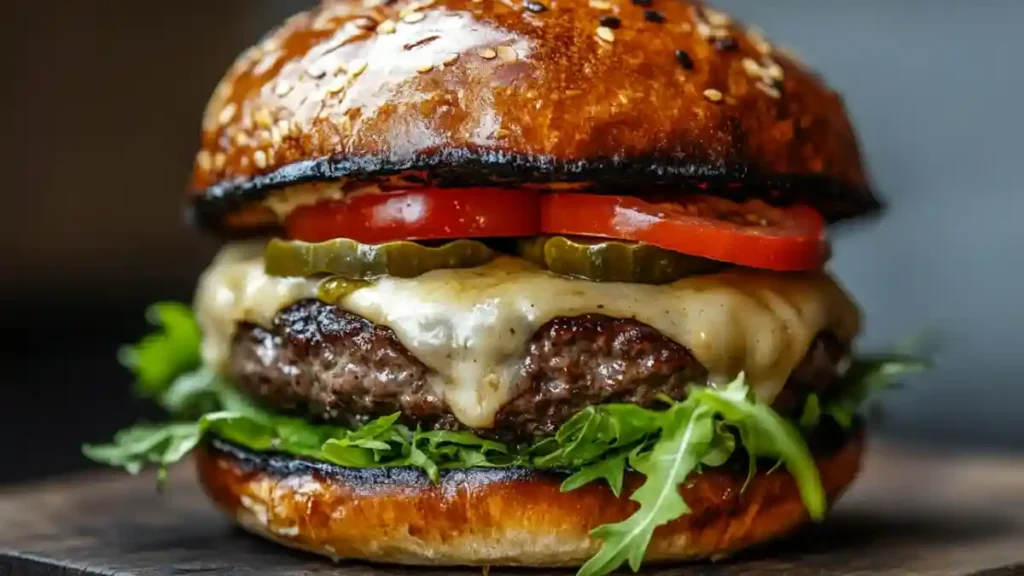
Challah buns aren’t just functional—they look upscale, too. Their deep golden hue and braided or domed shape add a rustic elegance that elevates any meal. Restaurants and gourmet food trucks often use challah buns to make their burgers stand out, and for good reason.
Want to build the perfect burger? Try this combo:
- Toasted challah bun
- Garlic aioli
- Grilled Angus beef patty
- Sharp cheddar
- Pickled onions
- Romaine lettuce
- Thick-cut tomato
Finish with the top bun and a toothpick flag, and you’ve got a burger worthy of any chef’s menu. Looking for the perfect side? Don’t miss our loaded tater tots recipe for the ultimate pairing.
If you’re planning a backyard BBQ, brunch, or even a dinner party, challah buns bring both taste and presentation to a whole new level.
Jewish Traditions and the Symbolism of Challah
The Religious Significance of Challah in Jewish Culture
Challah isn’t just another bread—it’s a sacred symbol in Jewish life. While the modern challah bun is often enjoyed casually with burgers or sandwiches, its roots are deeply spiritual.
In Jewish tradition, challah is served on Shabbat (the Sabbath) and during major holidays like Rosh Hashanah. Two loaves—called “lechem mishneh”—are placed on the table, symbolizing the double portion of manna that God gave the Israelites in the desert.
What makes challah especially meaningful is the “hafrashat challah” practice—where a small piece of dough is separated and burned as an offering, a mitzvah rooted in Torah law. This act reminds bakers of their connection to community, tradition, and divine blessing.
Although challah buns are a modern convenience, they carry the same spirit and significance. Families may bake small individual challah buns for personal blessings or festive meals.
| Ritual Element | Meaning |
|---|---|
| Two loaves on Shabbat | Double manna blessing |
| Hafrashat challah | Sacred act of offering |
| Braiding | Symbol of unity, love, and divine flow |
Want more on Jewish culinary roots? Discover great ideas like the ultimate cheese and crackers platter often found on Jewish celebration tables.
Why Challah Is Braided and Served on Shabbat
The signature braided look isn’t just aesthetic—it’s symbolic. The most common form of challah is the three-strand braid, representing truth, peace, and justice. Other braids may use four, six, or even twelve strands, each representing various spiritual concepts or tribes of Israel.
Some popular interpretations of the braided shape include:
- Unity and Connection: Multiple strands woven into one loaf reflect the interconnectedness of the Jewish people.
- Love and Devotion: Braiding by hand is often seen as an act of love, especially when passed down through generations.
On holidays like Rosh Hashanah, the braid is often replaced with a round challah, symbolizing continuity and the cyclical nature of the year.
Even if you’re not observing these traditions, baking or enjoying challah buns is a respectful nod to centuries of culture and faith. The buns may be smaller and unbraided, but every bite still holds meaning.
Storage and Serving Tips for Challah Buns
How to Keep Challah Buns Fresh
Challah buns are best when enjoyed the day they’re baked—but with the right storage methods, you can extend their softness and flavor for days.
Here’s how to keep challah buns fresh and delicious:
- Room Temperature:
Wrap buns in plastic wrap or place them in an airtight container. Store at room temp for up to 3 days. Avoid the fridge—it dries out the bread quickly. - Freezing:
Challah buns freeze beautifully. Wrap each bun individually in plastic wrap, then store in a zip-top freezer bag.
They’ll stay good for up to 3 months. To thaw, leave them at room temperature or warm in a low oven for 5–10 minutes. - Preventing Moisture Loss:
Adding a small slice of apple or a sugar cube inside the storage container can help retain moisture naturally.
| Storage Method | Timeframe | Pro Tips |
|---|---|---|
| Room Temp (wrapped) | 2–3 days | Avoid light and heat |
| Freezer | Up to 3 months | Double-wrap to prevent freezer burn |
Craving more cozy kitchen hacks? Don’t miss our popcorn with nutritional yeast recipe—a smart way to use extra yeast before it expires!
Reheating, Freezing, and Day-Old Recipes
Leftover challah buns are surprisingly versatile. They can be transformed into sweet or savory dishes with very little effort.
How to reheat without drying out:
- Wrap in foil and place in a 300°F (150°C) oven for 8–10 minutes.
- For a quicker option, microwave for 10–15 seconds with a damp paper towel on top.
Creative Day-Old Ideas:
- French Toast Sliders – Slice buns in half, dip in egg mixture, and pan-fry.
- Mini Bread Puddings – Cube stale buns, mix with custard, and bake in muffin tins.
- Challah Croutons – Dice and toast with olive oil, garlic, and herbs for salads.
Planning a meal around leftover challah buns? Try pairing with our easy mini chicken pot pies for a comfort-food dinner that repurposes beautifully.
The key is not to waste any part of this beautiful bread—every bite of a challah bun has the potential to be delicious again.
Recipes Using Challah Buns You’ll Love
Breakfast Sandwiches, Sliders, and Burger Recipes
Challah buns aren’t just for Shabbat or burger nights—they’re the ultimate multi-use bread for both savory and sweet dishes. If you have a batch ready (or even a few leftovers), here are creative, delicious recipes you can whip up:
1. Egg and Cheese Breakfast Buns
Toast a halved challah bun, then layer with a scrambled egg, cheddar, and a dash of hot sauce. Wrap in foil for an on-the-go breakfast.
Pair it with our omelet-in-a-bag breakfast solution for a high-protein combo.
2. Mini Brisket Sliders
Slow-cooked brisket + pickled onions + challah bun = Jewish deli meets game day. Serve with horseradish mayo for extra zing.
3. Avocado BLT on Challah
Spread mashed avocado on a toasted challah bun, add crispy bacon, lettuce, and tomato. Drizzle with garlic aioli for a gourmet finish.
French Toast and Bread Pudding with Leftover Buns
Don’t toss your day-old challah buns—they’re perfect for rich, custardy breakfast dishes.
1. Overnight Challah Bun French Toast Bake
Cube the buns and soak them overnight in a mix of eggs, milk, cinnamon, and vanilla. Bake the next morning for a fluffy, indulgent brunch. Add fresh berries for a sweet twist.
2. Challah Bun Bread Pudding with Chocolate Chips
Mix torn buns with heavy cream, eggs, sugar, and dark chocolate chips. Bake until golden and gooey. Serve with whipped cream or a dusting of powdered sugar.
3. Savory Herb Stuffing
Use cubed buns as the base for a Thanksgiving-style stuffing. Combine with sautéed onions, celery, rosemary, and broth, then bake. It’s a comforting way to upcycle leftovers.
Looking for another dessert bread idea? Try this decadent strawberry cheesecake dump cake—perfect alongside a lightly toasted challah bun with butter.
Whether you’re building burgers, making brunch, or repurposing leftovers, challah buns are versatile, delicious, and totally crave-worthy.
FAQs About Challah Buns
What is a challah bun made of?
A challah bun is typically made from enriched dough containing flour, eggs, sugar, oil, salt, and yeast. The dough is kneaded until smooth, then shaped into individual buns and finished with an egg wash for a golden, glossy crust. Optional toppings include sesame or poppy seeds.
What makes challah bread different?
Challah bread is distinct because it’s dairy-free, often braided, and features a soft, fluffy texture with a slightly sweet flavor. Unlike brioche, which contains butter and milk, challah uses oil, making it suitable for kosher meals that include meat.
What flour is best for challah?
Both all-purpose flour and bread flour work well. All-purpose creates a softer crumb, while bread flour provides more chew and structure. Many bakers use a 50/50 blend for the perfect balance of texture and rise.
Is challah good for burgers?
Absolutely. Challah buns are a popular choice for burgers because they’re soft yet strong enough to hold juicy patties and toppings without falling apart. Their mild sweetness also complements savory flavors, making them ideal for gourmet-style burgers.
Why do Jews eat challah bread?
Challah is traditionally eaten by Jews on Shabbat and major holidays. It symbolizes blessing, unity, and remembrance of God’s provision in the desert. The braiding often represents spiritual themes like love, truth, and peace.
Is challah just brioche?
No, challah and brioche are similar but not the same. While both are enriched breads, challah is made with oil, making it pareve (neutral for kosher laws), whereas brioche contains butter and milk, giving it a richer flavor but disqualifying it from meat-based kosher meals.
Conclusion
Challah buns are more than just another bread roll—they’re rich in flavor, tradition, and versatility. Whether you’re baking them for a Shabbat dinner, crafting the perfect burger, or making a sweet brunch treat, these golden, fluffy buns deliver every time.
You’ve learned what sets challah buns apart from brioche, how to bake and shape them, and even how to store and reinvent them into next-day recipes. From Jewish symbolism to their role in modern meals, challah buns truly bridge cultural heritage with everyday enjoyment.
Don’t miss our other baking guides like the homemade dinner rolls tutorial or basic egg wash recipe to level up your challah bun game. And for a flavor-packed side dish, try our loaded tater tots or ultimate cheese and crackers platter.
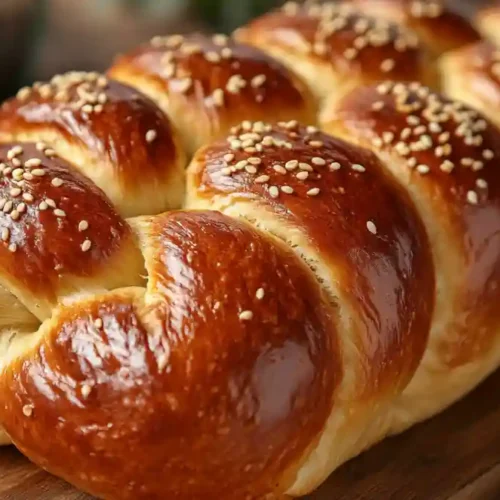
Classic Challah Buns
Ingredients
- 4 cups all-purpose or bread flour
- 2 ¼ tsp instant yeast
- 2 large eggs
- ¼ cup vegetable oil
- ¼ cup sugar
- 1 tsp salt
- ¾ cup warm water
- 1 egg + 1 tbsp water for egg wash
- Optional: sesame or poppy seeds for topping
Instructions
- Activate the Yeast (if using active dry):
- Mix yeast with warm water and a pinch of sugar. Let sit for 5–10 minutes until foamy.
- Combine Wet Ingredients:
- Beat eggs, oil, and sugar in a large bowl. Add yeast mixture and whisk until blended.
- Add Dry Ingredients:
- Gradually stir in flour and salt. Once it becomes too thick to mix, switch to kneading.
- Knead the Dough:
- On a floured surface, knead for 8–10 minutes until dough is soft, elastic, and slightly tacky.
- Don’t skip kneading—this is what builds the gluten needed for the buns to rise properly.
- First Rise:
- Place dough in a greased bowl, cover with a towel or plastic wrap, and let rise in a warm spot for 1 to 2 hours, or until doubled in size.

